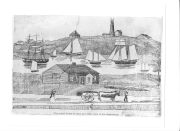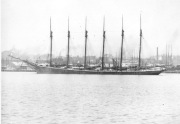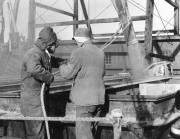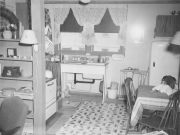
 |
 |
 |
 |
 |
 |
A Day in the Life of Portland Harbor
 |
| A view of Portland Harbor in the early 1800s. |
The waters of Portland Harbor have long been a center of human activity, shaping the lives and daily routines of those who live and work here. Even the physical outlines of the harbor and surrounding land masses have changed as a result of transformations in technological, economic, and social patterns. In 1853 the shoreline was filled to extend it from Front Street to Commercial Street, providing railroad access to the docks. Later, on the other side of the peninsula, much of Back Cove was filled in, and a portion of the shore right here in South Portland was filled for the naval shipyards in World War II. As you move through the "day" in this exhibition you will see a glimpse of the life of the harbor as it has evolved since the time Maine became a state in 1820.
| Casco Bay Steamers, from an old postcard postmarked 1910 |
Getting Around the Harbor: The first rays of the sun outlining the islands of Portland Harbor greet people of all ages and descriptions starting a new day. Some, like the lobstermen who get up before the sun to head out to haul their traps, are already well into their day by sunrise. While many today live on the islands and take a ferry to work and carry on their daily lives, most who work around the harbor arrive by car from neighborhoods and communities several miles away.
 |
| A six-masted schooner in the harbor, ca. 1900 |
Coal became a major import to Portland Harbor during the late 1800s and early 1900s, arriving from Hampton Roads, Virginia or Delaware Bay in huge six-masted schooners. In addition to home heating and cooking, it was used by railroads and other industries.
 |
| Loading grain from Portland grain elevator |
Portland has been an important port for goods going to and from Canada since the advent of the Atlantic & St. Lawrence Railroad (later the Grand Trunk) in 1853. Two huge grain elevators, built in 1875 to handle Canadian-grown grain, dominated the skyline for decades. Today, crude oil is unloaded at the pipeline right outside the Portland Harbor Museum and pumped directly to Montreal. Refined petroleum products, off-loaded at tank farms just beyond the Casco Bay Bridge, are imported for domestic use.Unloading cargo is an important job in any port. In the past, the hours were extremely irregular, depending on the somewhat unpredictable arrival of the ships that had to be unloaded. Over the years mechanical devices have lightened the heavy, manual labor involved. It was often a job held by recent immigrants and other minorities, such as African-Americans.
| A Welder at the South Shipyards during World War II |
Women and the Harbor: Middle-class ideals stressed women's role as mother and homemaker. However, few working class families could afford to live solely off the wages of the male head of household, so many women worked outside the home. Young single women might work as a domestic servant or in a factory. In the Portland harbor vicinity, that might be a job at a cannery, a clerical job in an office, or as a maid in the home of a wealthier family. By 1880 40% of office stenographers and typists were women. Clerical and office positions were considered more desirable, and not likely to be filled by immigrants and women of color.Labor shortages during World War II opened up new opportunities for women to work outside the home. Here in South Portland, where Liberty Ships were built, 3,700 of the 30,000 workers at the shipyards were women. They held down a variety of jobs, from welder to office worker.
 |
| Fort Scammel from an old postcard postmarked 1907 |
Portland
has long been a major port, and defense has played an important role in
the harbor during war and times of national emergency. A number of forts
were constructed to guard the harbor in the 1800s, and during World War
II, thanks to its relative proximity to Europe,
Portland was the fifth largest center of naval activity in the U.S. In
addition to the ship yard in South Portland, it was homeport for Commander
of Destroyers in the Atlantic Ocean -- the fighting ships which guarded
the North Atlantic convoys to Europe. In the early years of World War
II the 240th Coast Artillery Regiment of the National Guard was activated,
and mines and anti-submarine nets were put in place to protect Portland
Harbor, its shipbuilding facilities, and the anchored naval vessels.
 |
| Shipyard worker's housing in South Portland, ca. 1942 |
Maine has been predominantly a state populated by descendants of Europeans but Portland has long been home to a small but vital African-American community, with a large proportion of its members making their living in marine-related occupations. Until around 1900, African-Americans often found more economic opportunity on the sea than on land. At least in some cases, a crewmember's skill on board ship meant more than the color of his skin, and blacks made up a large proportion of the stevedores who unloaded ships prior to the arrival of Irish immigrants.
| Woman Fishing, ca. 1900 |
Today, as well as being a major entry point for cargo and a port-of-call for many cruise ships, Portland Harbor is one of the busiest oil ports on the east coast. In the aftermath of the events of September 11, 2001, security concerns are, unfortunately, once again a high priority.
The exhibit was made possible through a grant from the Margaret Burnham Charitable Trust and lead sponsor, Cole Haan.